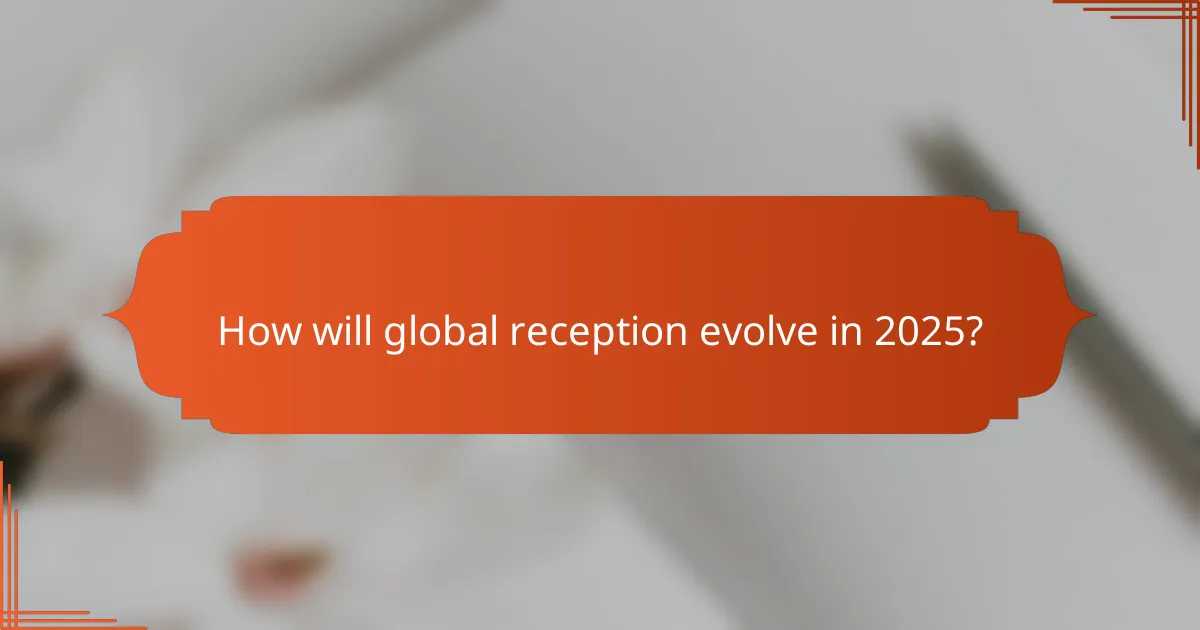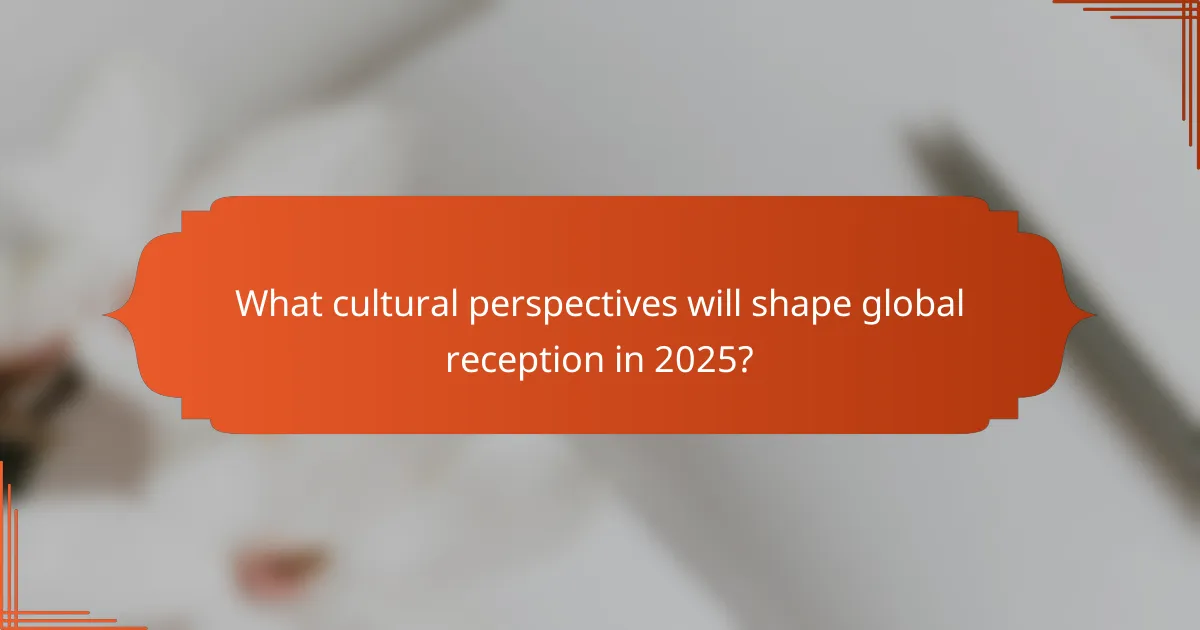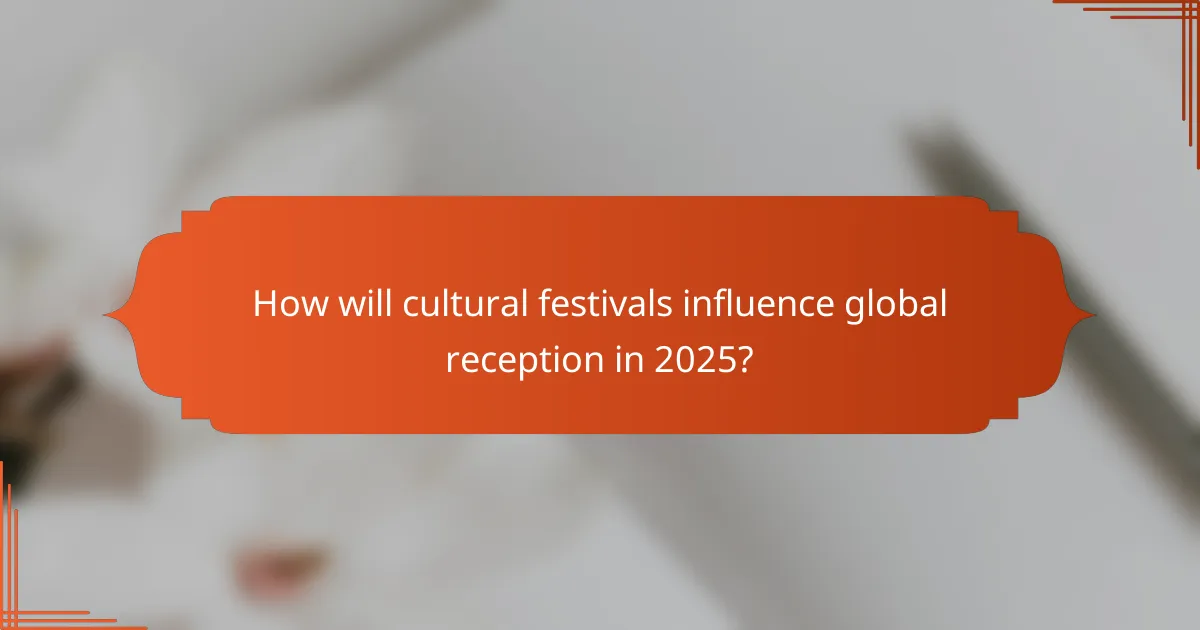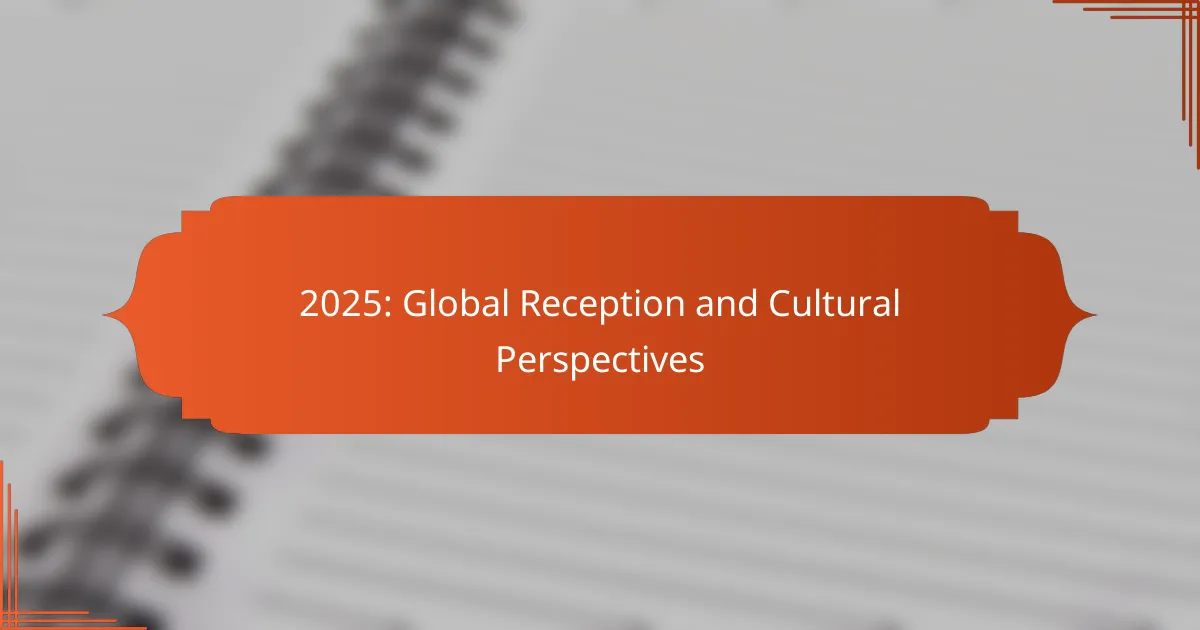In 2025, the global reception of cultural content will be profoundly influenced by technological advancements and evolving consumer preferences, fostering a more interconnected media landscape. Social media trends, regional conflicts, and international collaborations will shape diverse cultural perspectives, leading to varied interpretations among global audiences. As e-commerce adapts to these trends, businesses must prioritize personalized experiences and ethical practices to thrive in this dynamic environment.

How will global reception evolve in 2025?
In 2025, global reception will be shaped by advancements in technology, cultural shifts, and changing consumer preferences. These factors will drive a more interconnected and diverse media landscape, impacting how content is created and consumed worldwide.
Increased digital connectivity
By 2025, digital connectivity will be more widespread, enabling seamless access to content across various platforms. High-speed internet and mobile technology will allow audiences in remote areas to engage with global media, fostering a more inclusive environment for diverse voices.
As connectivity improves, content creators will need to optimize their offerings for different devices and bandwidths. This may involve creating lighter versions of websites and apps to ensure accessibility for users with slower connections.
Shift towards localized content
Localized content will become increasingly important as audiences seek media that resonates with their cultural backgrounds. In 2025, brands and creators will prioritize producing content in local languages and reflecting regional customs, enhancing relatability and engagement.
To effectively localize content, creators should consider cultural nuances and preferences. This may involve collaborating with local influencers or experts to ensure authenticity and relevance in messaging.
Rise of virtual events
Virtual events will continue to gain traction in 2025, offering global audiences the opportunity to participate in real-time experiences without geographical limitations. These events can include conferences, concerts, and workshops, providing interactive platforms for engagement.
Organizers should focus on creating immersive experiences through high-quality streaming and interactive features, such as Q&A sessions and networking opportunities. This approach can help maintain audience interest and foster community building.
Focus on sustainable practices
As awareness of environmental issues grows, there will be a strong emphasis on sustainable practices in global reception by 2025. Content creators and brands will adopt eco-friendly methods, such as reducing carbon footprints and promoting responsible consumption.
To align with sustainability goals, companies can implement digital solutions that minimize waste, such as virtual product launches and online marketing campaigns. Transparency about sustainability efforts will also resonate with increasingly eco-conscious consumers.
Emphasis on cultural inclusivity
Cultural inclusivity will be a key focus in 2025, as audiences demand representation and diversity in media. This shift will encourage creators to showcase a wider range of perspectives and stories, fostering a richer cultural dialogue.
To promote inclusivity, brands should actively seek diverse talent and collaborate with underrepresented communities. This not only enhances authenticity but also broadens the appeal of content across different demographics.

What cultural perspectives will shape global reception in 2025?
In 2025, cultural perspectives will be significantly influenced by social media trends, regional conflicts, international collaborations, and the emergence of new narratives. These factors will shape how global audiences perceive and engage with cultural content, leading to diverse interpretations and responses.
Influence of social media trends
Social media will continue to play a crucial role in shaping cultural reception globally. Platforms like TikTok and Instagram will drive trends, influencing how cultural products are shared and consumed. For instance, viral challenges or memes can elevate niche cultural expressions to mainstream visibility within days.
Brands and creators should monitor trending topics and adapt their messaging accordingly. Engaging with audiences through interactive content can enhance relatability and foster a sense of community around cultural themes.
Impact of regional conflicts
Regional conflicts will affect cultural reception by altering perceptions and narratives surrounding specific cultures. For example, ongoing tensions in areas like the Middle East or Eastern Europe may lead to heightened scrutiny of cultural representations from those regions. This can result in either increased empathy or backlash, depending on the context.
Content creators should be sensitive to these dynamics, ensuring that their work does not inadvertently perpetuate stereotypes or misunderstandings. Collaborating with local voices can provide authenticity and promote a more nuanced understanding of affected cultures.
Role of international collaborations
International collaborations will enhance cultural exchange and broaden perspectives in 2025. Joint projects between artists, filmmakers, and musicians from different countries can create hybrid cultural forms that resonate across borders. These collaborations often highlight shared human experiences, fostering global solidarity.
Organizations and creators should seek partnerships that reflect diverse viewpoints, as this can enrich the narrative and appeal to a wider audience. Funding opportunities for cross-cultural projects may also be available through various international grants and initiatives.
Emergence of new cultural narratives
New cultural narratives will emerge as societies evolve and respond to contemporary issues such as climate change, social justice, and technological advancements. These narratives will often challenge traditional storytelling methods, offering fresh perspectives on age-old themes.
Creators should be open to exploring these narratives, as they can resonate deeply with audiences seeking authenticity and relevance. Engaging with grassroots movements and local communities can provide valuable insights into the narratives that matter most to diverse populations.

How will e-commerce adapt to global reception trends in 2025?
In 2025, e-commerce will increasingly adapt to global reception trends by focusing on personalized experiences, leveraging advanced technologies, and expanding ethical practices. Businesses will need to embrace these changes to remain competitive in a rapidly evolving market.
Personalized shopping experiences
Personalized shopping experiences will become a cornerstone of e-commerce strategies. By utilizing data analytics and customer insights, retailers can tailor product recommendations and marketing messages to individual preferences. This approach not only enhances customer satisfaction but also drives higher conversion rates.
For example, platforms may use browsing history and purchase behavior to suggest items that align with a shopper’s unique style. Implementing AI-driven chatbots can further personalize interactions, providing real-time assistance and product suggestions based on user queries.
Integration of AR/VR technologies
The integration of augmented reality (AR) and virtual reality (VR) technologies will transform how consumers interact with products online. These technologies allow customers to visualize products in their own environment or experience immersive shopping environments, enhancing engagement and reducing return rates.
For instance, furniture retailers may offer AR apps that let customers see how a piece of furniture looks in their home before making a purchase. Similarly, fashion brands could use VR to create virtual fitting rooms, allowing shoppers to try on clothes digitally.
Expansion of cross-border e-commerce
Cross-border e-commerce will see significant growth as consumers become more comfortable purchasing from international retailers. This trend will be fueled by improved logistics, payment solutions, and localized marketing strategies that cater to diverse cultural preferences.
Retailers should consider offering multiple currency options and localized customer service to enhance the shopping experience for international customers. Additionally, understanding regional regulations regarding shipping and returns will be crucial for successful cross-border operations.
Focus on ethical sourcing
As consumers become increasingly aware of sustainability issues, a focus on ethical sourcing will be vital for e-commerce brands. Companies will need to demonstrate transparency in their supply chains and prioritize environmentally friendly practices to attract socially conscious shoppers.
Brands can implement strategies such as sourcing materials from sustainable suppliers, ensuring fair labor practices, and reducing carbon footprints. Highlighting these efforts in marketing campaigns can resonate with consumers who value ethical considerations in their purchasing decisions.

What are the key criteria for evaluating cultural reception?
Key criteria for evaluating cultural reception include audience engagement, market research insights, and content relevance analysis. These elements help determine how well a cultural product resonates with its intended audience and the broader market.
Audience engagement metrics
Audience engagement metrics assess how actively audiences interact with cultural content. Key indicators include social media shares, comments, likes, and time spent on content. For example, a film that garners high social media engagement may indicate strong cultural resonance.
Consider tracking metrics over time to identify trends. A sudden spike in engagement can signal a cultural moment or shift, while consistent low engagement may suggest a need for content reevaluation.
Market research insights
Market research insights provide a deeper understanding of audience preferences and behaviors. Surveys, focus groups, and demographic analysis can reveal what specific cultural elements appeal to different segments. For instance, younger audiences may prefer digital formats, while older demographics might favor traditional media.
Utilizing tools like Google Trends or industry reports can help identify emerging cultural trends and consumer interests. This data can guide content creation and marketing strategies to better align with audience expectations.
Content relevance analysis
Content relevance analysis examines how well cultural products align with current societal values and trends. This involves evaluating themes, narratives, and representation within the content. For example, a film that addresses contemporary social issues may resonate more strongly with audiences than one that does not.
Regularly reviewing and updating content to reflect changing cultural contexts is crucial. Engaging with diverse voices during the creation process can enhance relevance and appeal across different audience segments.

How will cultural festivals influence global reception in 2025?
Cultural festivals are expected to significantly shape global reception in 2025 by fostering connections among diverse communities and promoting cultural exchange. These events will serve as platforms for dialogue, understanding, and appreciation of various cultural heritages, ultimately enhancing global interconnectedness.
Increased participation in global festivals
In 2025, cultural festivals will likely see a surge in participation from both local and international audiences. This increase can be attributed to the growing interest in cultural experiences and the desire for personal connections across borders. Festivals that offer interactive activities and immersive experiences will attract larger crowds, creating vibrant atmospheres.
Organizers should consider implementing early-bird ticket pricing or group discounts to encourage attendance. Additionally, promoting festivals through social media and local partnerships can enhance visibility and draw in diverse participants.
Hybrid festival formats
The hybrid festival format, combining in-person and virtual experiences, will become more prevalent in 2025. This approach allows festivals to reach a broader audience, accommodating those unable to attend physically due to distance or other constraints. By offering live-streamed performances and virtual workshops, festivals can engage global participants effectively.
Event planners should invest in quality streaming technology and user-friendly platforms to ensure a seamless experience for virtual attendees. Clear communication regarding access and participation options will also be essential to maximize engagement.
Showcasing diverse cultural expressions
Cultural festivals in 2025 will increasingly focus on showcasing a wide array of cultural expressions, reflecting the rich tapestry of global traditions. This includes music, dance, art, and culinary experiences that highlight the uniqueness of different cultures. Festivals that prioritize inclusivity and representation will resonate more with audiences.
To enhance cultural representation, organizers can collaborate with local artists and cultural ambassadors to curate authentic experiences. Providing platforms for underrepresented communities will not only enrich the festival but also foster a sense of belonging among diverse participants.
